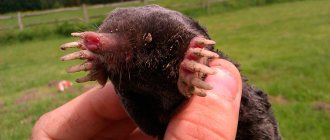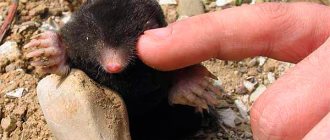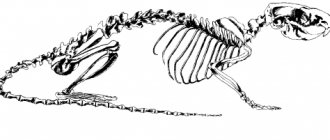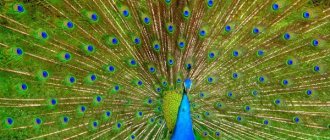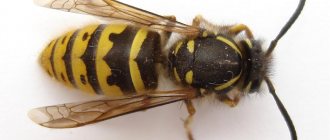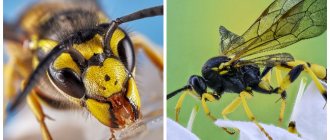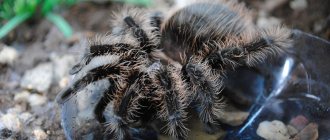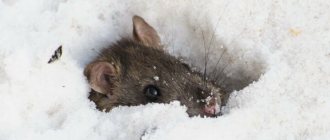- Wild animals
- >>
- Mammals
There are a lot of animals in nature that know how to dig tunnels underground. However, the most famous digger, known since childhood, is the mole . This mammal spends most of its life underground, which is facilitated by the special body structure and physical capabilities of the mole. This is a unique creation of nature, which brings both unconditional benefit and quite serious harm to humans.
General description of the species
Moles are a family from the class Mammals, belonging to the order Insectivores. They live in Europe, Asia and North America.
Appearance
The mole looks like a small animal, body length 5–20 grams, weight varies from 9 to 170 grams. Animals are adapted to underground life. The body is rounded, oblong, covered with velvety smooth fur. It always grows straight, which allows it to lie in any direction while digging.
The fur color is black or dark brown. The animal molts in spring, summer and autumn. The paws are small, the front paws are spade-shaped, the hind paws are underdeveloped.
Other external features include:
- small tail;
- a nose made in the form of a movable proboscis;
- absence of ears;
- small oblong head;
- externally invisible neck.
The eyes are poorly developed and lack a retina and lens. The eye openings are small, covered by movable eyelids. In some species, the eyes completely become overgrown. The animals have highly developed senses of hearing, touch and smell.
Characteristic
Moles by nature are predators that eat small insects and larvae. They prefer areas with soft, loose soil that is easy to dig with their paws. In summer, their tunnels are laid close to the soil surface.
In winter, animals go deep into the ground. They do not hibernate, but only greatly reduce their activity. They feed on stocks of worms that are kept alive but paralyzed. To do this, the animal bites off their head.
Habitat
Moles live everywhere in Eurasia and North America. In Russia they are found in the central zone, in the North Caucasus, the Urals and Western Siberia. In the east of the country they live up to the confluence of the Irtysh and the Ob. The northern border of the animals’ habitat runs along the Siberian taiga, and the southern border extends to the forest-steppe zone. All that is important for these animals is that the soil is suitable for digging. They are almost never found in swampy areas.
In Asia, moles are found in China, Turkey, Indochina, Tibet, Mongolia, and Transcaucasia. They are found in the western United States, southeastern Canada, and Mexico.
Population and status
The density of mole populations depends on both the specific species and the area. Males usually increase their density in the spring. In view of this, there are 5–30 individuals per hectare of soil.
Today they have emerged from the status of endangered animals. This is due to the fact that they are almost no longer hunted. Warm winters also have a good effect on the survival of animals.
Appearance and features
Photo: Animal mole
The main feature of these small animals is the lack of vision. If for humans and other animals the lack of vision is a serious defect, then for moles it is considered the norm and even a necessity. Having normal eyes, these animals simply would not be able to spend almost their entire lives underground. Moles have eyes, but in most species they are additionally protected by a layer of skin.
Not only the organs of vision are completely adapted to underground life. The hearing organs are also adapted to it. Moles do not have ears. This is also not just provided by nature. If there were ears, then too high pressure would form in them. Such pressure would not allow the animal to be in the soil.
Diggers have fur that is very pleasant to the touch. It also has some features that differ from the fur of other animals. The mole fur covering can be easily folded in different directions. This property allows animals to slip into narrow underground tunnels without problems. The color of the fur is usually black, brown or dark gray.
The appearance of moles can be characterized by the following parameters:
- The total length of the animal is about sixteen centimeters. Of this, the body occupies approximately seven centimeters, and the rest is the length of the head and tail.
- The average weight of the animal is fifteen grams. However, representatives of the family of larger sizes are known. For example, scientists came across the Ussuri mogera, whose length is twenty-one centimeters.
- The body shape of this mammal is bar-shaped. Moles have a tiny head and an almost invisible neck. The auricles of most members of the family are undeveloped, while in others they are very small and covered with hair. Animals also have a nose in the form of a small proboscis. It contains sensitive hairs. The nostrils are directed forward.
- The mammal's paws have five toes. They are the main tool for digging long tunnels. The paws are strong and have claws. The hands resemble shovels; they are turned with the palms facing outward. The mole digs tunnels with its front legs, while its hind legs are less strong. They are very thin and resemble the paws of rats.
Burrow construction
The mole spends most of its life underground. Only to develop a new area does it come to the surface. The animal digs two types of tunnels:
- veins;
- search engines
The first ones are also called nests; the mammal rests and hides in them during the cold season. They lie at a depth of 10−90 cm, and their diameter is only 5 cm. Closer to the surface, the mole makes search passages. He digs them so that earthworms and other underground invertebrates live nearby. The network is extensive, it can occupy significant areas - hundreds of square meters. Moles leave traces behind them: soil rollers that appear due to the swollen arches of passages.
The animal digs the ground with its front paws, and rests against the already compacted walls of the hole with its hind paws. At a depth of 10 cm, the mammal can no longer raise its head, so it throws the soil to the surface.
These heaps are called molehills; they reach 15–25 cm in height and up to 1 m in diameter. They are usually gathered in small groups. Molehills are the only sign of the presence of moles on the site that a person can detect.
What do they eat?
The menu mostly consists of invertebrates. They obtain about 90% of their food in feeding passages (tunnels). Moles are omnivores and can eat any food available to them on the site, but most of all they prefer beetle larvae, earthworms and slugs.
In the first half of autumn, the mole stores food supplies near its home. They usually consist of worms, which the animal immobilizes with a bite. The volume of such “preservation” in some cases reaches 2 kg.
Animal eye degeneration as a form of natural selection
From the point of view of evolutionary theory, the gradual simplification of the structure of the mole's eyes and the loss of many functions by them is a way of adapting to the lifestyle that this animal leads. Moreover, the regression of the animal’s vision system is associated not only with the lack of need for a clear visual picture, but also with the harmfulness of full-fledged eyes underground.
For example:
- If a mole had normal large eyes, like, say, rats or mice, then with constant digging of underground passages, earth and dust would get into them. This would lead to eye contamination, inflammation, suppuration and death of animals. The smaller the eyes, the more difficult it is to damage them, and when they are constantly closed with eyelids, they are reliably protected from external influences;
- Since the sense of smell is much more important for moles, most of the analyzers in the brain are responsibly focused specifically on processing information from olfactory receptors (in star-nosed moles, the sense of touch also plays an important role). The involvement of extensive brain structures in processing visual information would not be rational.
The photo below shows the eye of the Iberian mole:
By and large, moles at this stage of their evolution are moving towards the complete disappearance of their eyes. This form of natural selection, according to different classifications, is:
- Driving - with it, an advantage in survival is found in animals that deviate from the norm of development of a particular trait. The norm is predominantly open, not very small eyes, but in the case of moles, individuals with constantly decreasing eyes that close with eyelids more often survived. That is, natural selection moves these animals towards complete degeneration of vision.
- Cutting off, since individuals with “normal” eyes died more often due to eye lesions.
By the way, it is precisely these forms of selection that are characteristic of almost all animals with certain reduced organs. Including for people who have practically degenerated the muscles that move the ear, or, for example, the coccyx, in the place of which their ancestors had a tail.
What kind of life do they lead?
Moles are almost always underground. All individuals are equally active both at night and during the day. Over the course of a day, animals experience several three- to four-hour stages of increased mobility, and in the intervals between them the animals rest in their nests.
Moles are characterized by a predominantly sedentary lifestyle. Only sometimes, in hot weather and drought, do they move approximately 1–1.5 km from their habitats in search of water.
Moles are loners. They live in their own individual plot, which they bravely defend from enemies to the best of their ability. Each of them has its own tunnel system, but sometimes they overlap. The animals still try not to collide with each other and get food in various secluded corners.
If a mole dies, the neighbors quickly notice it, and the fastest one wins the free area. Sometimes it is shared by several animals.
Having captured a certain territory, moles mark the tunnels laid there with a powerfully smelling secretion secreted by the preputial glands. Both males and females have this smell. If this “aroma” is not present, other individuals will conquer the area.
Molting of moles
The periodic change of fur, molting, in moles occurs not 2 times - in spring and autumn, as in many animals, but 3 or even 4 times, since moles molt in the summer. This is due to the fact that with constant movement through narrow passages, the animal’s fur quickly wears off. It turns out that the mole sheds completely or partially almost all the time, except in winter. In faded areas, the skin darkens and thickens three times, but the hair in this area is weaker and is quickly wiped off.
The mammal's first molt occurs from April to June. Females molt first, and then males. Worn winter fur is replaced with new spring fur. In mid-July, the adults, followed by the young (for the first time in the young), undergo summer molting. Following it, almost without interruption, the autumn molt begins, at the end of which the moles acquire their best appearance. The mole's autumn fur is velvety, shiny, black with a silvery touch, very thick and tall.
What is the difference between a mole and a shrew?
- Moles live mainly underground. Shrews lead a terrestrial or semi-aquatic lifestyle.
- The tail of shrews is always long and reaches more than 2/3 of the body length. Most moles have a short tail: its length varies from 2 to 10 cm depending on the type of animal. True, in shrew moles from the subfamily Uropsilinae, the length of the tail is equal to the length of the body.
- Shrews have fewer teeth - from 26 to 32. Moles have 34 - 44 teeth, depending on the type of animal.
- The diet of shrews is more varied than that of moles, which feed mainly on earthworms and insects. Shrews are also insectivores, but can also eat lizards, small rodents, carrion, nuts, and berries.
- Many moles (with the exception of some species, for example, the great moger) give rise to one litter per year. Shrews may have 2 or 3 of them.
- Moles live in forest and forest-steppe zones of Eurasia and North America. Shrews are found in Africa and South America. In Eurasia, they are more widespread than moles, inhabiting, in addition to forests and steppes, semi-desert zones, tundra and forest-tundra on the mainland, as well as Sakhalin, the Kuril, Japanese, Malay and other islands. They rise higher than moles into the mountains, reaching the edge of glaciers.
On the left is a common mole (lat. Talpa europaea), on the right is a shrew (species - common shrew, lat. Sorex araneus). Left photo: Mark Zekhuis. Photo on right: Sjonge, Public Domain.
Nutrition
The diet of the vast majority of moles consists of earthworms. In second place are insects living in the ground and their larvae, such as wireworms (larvae of click beetles), weevils, mole crickets, beetle larvae (including the May beetle) and flies, and cutworm caterpillars. Many moles eat slugs. Starfish eat aquatic inhabitants: small crustaceans, aquatic insects and fish. Mogers include caterpillars of various species of butterflies in their diet. Scapanus moles and American shrew-moles partly consume plant foods.
Moles feed 5-6 times a day. After each meal, the animal tucks its head and hind legs under its abdomen, taking the shape of a fluffy ball, and falls asleep for about 4 hours. It is during this period of time that food is digested. At one time, an animal can eat about 20-22 g of earthworms, and 50-60 g per day. The mole eats whole or torn worms, starting from the end. Using the teeth and toes of his front paws, he squeezes the soil out of them. Moles are capable of fasting for a maximum of 14 to 17 hours. In summer they eat more food than in winter.
Sometimes moles store food for periods of starvation. From 100 to 1000 earthworms can be collected in underground mole tunnels. Moles immobilize them with a bite to the head, and the worms remain alive for some time.
To search for earthworms, moles do not dig new tunnels every time. They find food in previously made tunnels. The worms themselves crawl into them, attracted by the warmth and smell of the musk secreted by the mole. In winter, earthworms are just as active as in summer. They are able to make moves in frozen ground, crawling to the surface. Moles hunt for them, digging tunnels under the snow.
More about mole labyrinths
When exploring a new plot, moles have to get out into the fresh air. Even for one animal, a large area is occupied by moves. They come in two types. The first ones are called residential. They lie at a depth of 6 to 90 cm and have a radius of 2.5 cm. The animal moves through these holes to the feeding site or watering hole. Other moves are needed specifically for obtaining food. Animals usually lay them in the upper soil layers, where the soil is not too dense. In addition, this is where worms and larvae live - the main food of moles.
Sometimes traces of these passages are visible even on the surface of the earth. They appear as soil ridges of great length, formed by swollen arches of passages. This happens if an animal makes a tunnel for itself next to the ground surface, and its arches cannot withstand the pressure of the animal.
When making new passages, the mole focuses on its hind limbs and digs the ground with its front limbs. They alternately penetrate the ground and move laterally and backwards. After this, the animal tamps the soil with its strong head, pressing it against the running walls.
If a hole is dug at a depth of 10 cm or more, then the animal does not lift the arch with its head. He has to throw the excavated soil outside. As a result, molehills appear - earthen heaps. They are usually small, no more than 15–25 cm in height. Their diameter is also small, but in some cases it reaches a size of a meter.
Reproduction
Moles breed once a year. The gestation period for the young varies from species to species. In the Siberian mole there is a period when the embryo stops developing for some time.
The breeding season for “Russian” moles is different:
- The European mate in March-April. The female bears offspring after 35–40 days. The cubs are blind and naked. There are 3–9 moles in a litter, weighing 2–3 g. The female gives birth once a year. Only a fifth of adult moles can produce a second litter in the summer. At 1.5 months the young animals leave the family.
- The Siberian mate mates in June, but the female gives birth the following year in April–May, since the Altai species has diapause and a total pregnancy of the mole lasts 270 days. There are 3–6 cubs in a litter. In June, young animals consider themselves adults and leave the nest. But sexual maturity in females occurs only after a year, in males after two.
- The blind mate in February–March while still under the snow. The mole bears offspring for 30 days. There are from 1 to 5 cubs in a litter. These animals grow to the size of an adult within a month, after which they leave the nest.
- The Caucasian also mates in February. The female brings moles in March. There are 1–3 cubs in a litter. After 40 days they become independent.
With such a small number of young and breeding only once a year, the number of moles in an area can increase very quickly. Since the mole gives birth deep underground, her offspring are not threatened by any predators and all the cubs remain alive.
But how long a mole representative lives depends on its species. The lifespan of the common mole is 4–5 years, the Altai mole is 5 years, the blind mole is 3–4 years, and the Caucasian mole is 5 years.
Starfish
Known under the names star-nosed mole, star-nosed mole, star-nosed mole, star-nosed mole. In appearance it is similar to most other moles, but differs in its elongated tail (6–8 cm) and hard fur that does not get wet. There are two skin growths on the face, similar in appearance to an asterisk, which is where the name of the individuals comes from. Animals in adulthood weigh up to 85 g. The eyes are small, but clearly distinguishable in appearance. Lives in the eastern regions of North America.
Western American
The body length of the animal is 11–14 cm, while the tail can take up to 5.5 cm. Body weight reaches 170 grams. The proboscis of the muzzle is moderately elongated. The eyes are small, hidden under the fur. There is no external auricle. The hand of the foot is very wide. The tail is thick, covered with sparse hairs. Distributed in North America.
Short-faced
A small species of the Mole family. Lives in China.
Long-tailed
Lives in Asia. Body length 7–9 cm, weight up to 12 grams. There are no auricles. The front legs are slightly widened and equipped with almost straight claws.
Chinese shrew
Distributed in the Chinese province of Sichuan. It lives mainly in forests of the temperate zone.
Caucasian
Outwardly, it almost completely resembles a European mole. It stands out only for its rudimentary eyes covered with thin skin. It has large teeth and velvety fur. It can burrow to a depth of 1 m. It eats up to 40 g of food per day.
Blind
The smallest mole in our country with a body length of 8–12 cm, weight – no more than 30 grams. The eyes are covered with thin skin. Tail length is about 3 cm.
Japanese mogera
It lives in the southern territories of Japan, as well as in China, Korea and the south of Primorsky Krai. Prefers to live in cultivated fields and meadows.
Natural enemies
Moles don't have many enemies. A specific smell saves them from predators. Sometimes they can still be caught by birds of prey. This happens during spring floods. The animals' enemies are martens, wild boars, badgers, foxes, and raccoon dogs.
The only predator that is the main enemy of the mole is the weasel. She happily sneaks into their passages and catches them. The weasel does not even disdain the musky smell of a mole, which other animals do not like so much.
During the rutting period, the weasel makes a sound that moles always recognize and, sensing danger, run away. Droughts and waterlogging can kill moles. People are also the cause of the death of these animals, as they are capable of killing them either accidentally or intentionally.
Main varieties
The classification of moles implies the existence of over 40 species. Among them, the most common are about one and a half dozen subspecies.
Blind
The main difference from its relatives is the complete absence of eye holes. Individuals are medium-sized, covered with dark brown fur. The range extends to the Caucasus, northern and eastern regions of Turkey, and Iran.
Ussuri mogera
Unlike species that have underdeveloped eyes, the Ussuri mogera has no eyes at all. It is found in the Primorsky Territory of Russia, as well as in northeast China. This is the largest mole among all known species on the planet. Its length can reach 21 cm, and its weight is 300 grams.
Long-tailed
The animal is distinguished by its small body size (8-9 cm) and a relatively long tail, which can reach a length of 4-4.5 cm. It lives in eastern Asia: China, Vietnam.
Caucasian
The name indicates the habitat of the animal. The Caucasian mole is of medium size, dark brown fur, and its tail reaches 3 cm in length.
Starburst
An inhabitant of North America and Canada with a rather unusual appearance. The animal is distinguished by its rather large size: body length - 20 cm, tail length - 7-8 cm. Unlike other moles, the animal has a stigma formed from many movable fleshy processes, reminiscent of the tentacles of a starfish.
Another feature of the starfish is the ability to move through the snow, swim, and dive under ice. In addition to the insects and worms familiar to moles, the starfish eats fish and shellfish caught in the water.
European
Found in Europe and Asia. The animal is of medium size and has a relatively short tail (2-3 cm). The coat color is dark gray, almost black, with the belly being noticeably lighter.
European moles breed once a year, the first coat of the young is light, later the color becomes dark.
East Asian
Animals from the Mole family. They are found in mid-mountain meadows and forests of East and Southeast Asia. Little studied, do not have well described characteristics.
Mogers
Moles with a body length of 9–25 cm and a weight of 290–300 grams. They differ from their relatives of other species in their brownish-brown hair, the specific structure of the auditory apparatus and pelvic bones. There is no fang in the lower jaw. The eyes are covered with leathery membranes and are not visible from the outside.
Ordinary
The animal is known as the European mole. It has a rounded oblong body, an elongated muzzle and a short neck. The limbs are small, adapted for digging. The front legs end in spade-shaped palms that are turned outward. They have powerful claws.
The eyes are partially covered with skin. The hairline is thick and short. This genus is most common in the Mole family.
Japanese shrew
The only representative of the species, so named for its resemblance to shrews. The difference between the species is the ability to live in trees. He can arrange a home for the press both underground and in a nest.
Diet: benefit or harm for humans?
It's time to answer the question of what a mole eats. As already mentioned, the food for these burrowing animals is mainly insects. However, their diet can be somewhat expanded on occasion.
Moles feed on any available animal food. These predators can even feed on small animals such as mice or frogs.
It must be said that this insectivorous predator has a very fast metabolism, and for this reason is quite voracious. Weighing 80-90 grams, many animals of this family are able to absorb up to 140 grams of organic food. You won’t immediately find such gluttons who would eat all day long.
It is also necessary to dispel the myth that these diggers eat vegetables and root crops, spoiling the harvest. This is not entirely true. We have already figured out what a mole eats. Now let's say a few words about the relationship between this animal and man.
The war that man has declared on this animal has been going on for decades, and the reason for it all is that the blind mole digs the ground and, while making its holes, thereby touches roots and tubers.
Also, in pursuit of prey, digging the ground near the root systems of plants, the animals also grab pieces of roots or harvest items, thus falling out of favor with farmers.
At the same time, a blind mole can not only cause harm, but also be beneficial. These animals dig the ground, thus loosening the soil, and thanks to the molehills, air enters and the soil is enriched with oxygen in the depths. This is what benefits moles bring to the soil.
Where do moles live
Various species of moles are found in North America and Eurasia. Their distribution area is limited to the temperate and subtropical climate zone.
How deep in the ground do moles live?
Moles are constantly on the move and can make up to 50 m of new passages per day. In the occupied territory, animals build a whole multi-tiered system of burrows connected to each other for various purposes.
In loose soil, the mole moves at a depth of 5-10 cm, lifting the soil at the site of the tunnel construction. The depth of the passages in the soil that dries out from above reaches 50 cm. If it is necessary to build passages at great depths, the animal periodically digs vertical branches through which it throws out excess soil. Small earthen mounds are the main sign of the presence of an underground inhabitant on the site. The nest in which it rests between searches for food is located at a depth of 1.5-2 m.
From time to time, the animal makes the rounds of already dug feeding holes in search of prey that has fallen there, and also builds new passages.
Natural habitats
Moles are found almost throughout the Euro-Asian continent, in the USA, Canada, Mexico, etc. The only place where there are no moles is in the polar regions, and this is not surprising, since in these areas the soil is constantly frozen. It is very important for these animals that the nature of the soil allows them to dig underground tunnels. Almost all species avoid swampy areas.
Molehills can be found everywhere: in forest clearings, meadows, forest edges, deciduous forests, agricultural lands, plains, hills and even mountains. At the same time, moles cannot be found in semi-deserts and deserts, which are characterized by too hot a climate. Moles dig holes for themselves, and their purpose is twofold: firstly, they need them as their home, and secondly, without digging holes, they will not be able to get food for themselves.
Mole's labyrinths - system of moves
Under the ground, the mole digs tunnels that can reach depths of several hundred meters. This system of underground passages can be used by several generations of moles. A mole sleeps in a nest lined with dry grass.
When a mole digs the ground, it screws into the soil like a screw, scraping away the soil with its front paws. At this place a molehill is formed (a small hill of earth hiding the entrance to an underground tunnel).
Since the mole does not have incisors, like rodents, it cannot dig in hard soil, so it prefers pliable soil. If there are paths on the mole’s path, he makes a special “underground passage” to get around them. Often other animals also use these crossings.
The mole can also swim across small rivers, but it rarely appears on the surface. It is uncomfortable for him to move on the ground, since he is used to crawling, and the mole also does not see anything.
The entire life of a mole passes in underground passages, which he makes in different layers of soil. Moles dig two types of tunnels:
- residential - passages that are used to move to the nest, watering hole, and feeding areas;
- feed - traps for insects, invertebrates, which the mole eats.
During the night, a mole can build up to 50 m of tunnels. Its nest is located 1.5-2 m underground. As a rule, it is located in a protected place - under stumps, between tree roots, under buildings. The nest is connected to the stern passages using inclined drifts.
The mole's underground tunnel system is multi-tiered. The mole makes its feeding passages closer to the surface. From the outside, they are visible in the form of earthen ridges without earth emissions. The diameter of the underground rooms is 5-5.5 cm.
Molehills.
The mole tunnel is a trap for earthworms. Worms are attracted by the smell of mole musk, as well as by the slightly higher air temperature inside the mole tunnel. The attractiveness of mole tunnels for worms is also enjoyed by shrews, which often climb into them and eat the worms before the host mole. Other animals use the snow mole tunnels - mouse-like rodents, even weasels and stoats.
In open areas of the earth, where the soil often dries out, the mole makes moves at greater depths. In this case, he cannot lift a thick layer of earth, and throws out excess earth through temporary holes (vertical tunnels), called molehills. Sometimes the molehill can reach a size of 70-80 cm.
European moles do not hibernate; they are active all year round. And even in cold winter they can make tunnels in soil that is not frozen.
If the winter is harsh and there is little snow, the ground freezes to a depth of about 0.5 - 5 m, then the mole may die from the cold. Droughts are also dangerous for these animals.
Features of character and lifestyle
Photo: Common mole
Almost the entire life of a mole is spent in complete darkness. They build incredible labyrinths in which they then live and hunt. Labyrinths can lie at different depths in the ground. Digging takes an animal a lot of time. Above the passages, which are located close to the surface of the earth, you can always notice a characteristic roller. The depth of the labyrinths depends on the type of soil. If it is loose and wet, the passages are made at a shallow depth; in dry soil, channels are dug at a depth of twenty centimeters.
The deepest tunnels are dug by animals under forest paths. Nests are also located at great depths. On average, females build nests at a depth of 1.5 meters. The nest is carefully lined with grass and leaves. Animals can from time to time roam around the area where they live. In the summer they descend to the lowlands, in the spring - to the hills. In spring, male moles can expand their territory several times. This is due to the search for a female for reproduction.
Moles have a contradictory character. They are grumpy and quarrelsome. Very rarely animals live in a group. They unite in pairs only when the time comes for the mating season. Moles show friendliness only at a young age. Young individuals caress each other. But with the process of growing up, not the best qualities begin to appear - grumpiness, pugnacity.
Adults often start fights if they meet each other on the way. They are capable of mercilessly biting to pieces an opponent. It is not surprising that in captivity, representatives of the family eat the meat of their relatives with great appetite. Also, moles do not have empathy. If their neighbor gets into trouble or dies, there will be no help. Moles quickly occupy the tunnels of the dead animal and use it for their own purposes.
Number and economic importance of moles
If a mole is at home underground, then on the surface of the earth he is in danger. It can become prey for birds of prey (owls, gulls, herons), as well as foxes and wolves. Therefore, an animal is born, lives and dies in the ground, coming to the surface only in exceptional cases. There he spends a minimum of time, running away into his hole again at the first opportunity.
Moles are numerous animals and do not need protective status. Moles are prized for their fluffy fur. The mole skin is thick and velvety. It was popular in the 19th century. But today it is not used in industry - it turned out that it is not durable.
The benefit of moles is that they exterminate harmful insects and change the structure of the soil, making it looser and enriched with organic matter. Digging tunnels helps ensure that excess moisture from the top layer of soil goes into the lower layers.
But besides the benefits, the mole causes harm to agriculture, especially to people involved in gardening. Digging underground passages, the mole often damages the roots of plants, which leads to disruption of their normal nutrition, causing death. The mole also feeds on earthworms, which are very beneficial for the soil.
They fight mole pests using a variety of methods: by placing products with a pungent odor (onions, garlic) and a rag soaked in kerosene in the mole tunnels. Moles are also repelled with sound signals and ultrasound.
General information
The mole belongs to the order of insectivores. In Russia and the CIS countries it is very widespread. Prefers meadows with moderately moist soil, forests with deciduous bushes and birch forests. He is very fond of forest edges, railway tracks, clearings, clearings, in general, all places that are open to the sun.
The mole will not settle in coniferous forests, swamps, meadow lowlands, among trees with a powerful root system. The animal needs soil of moderate humidity, black soil with humus. There is plenty of food there - insects, worms, larvae. In areas with strong temperature changes, the animal will stay closer to the forest. Severe winters often cause mass deaths of moles. They live in the upper ground layers, and there will be a clear shortage of food, which will descend much lower underground, hiding from severe frosts.
Beneficial features
The European mole has useful traits. They are expressed in the fact that the animal was previously an object of the fur trade. The mammal has beautiful and durable fur. At the beginning of the last century, moles were hunted for their valuable skins. But the massive catch led to the fact that the animal began to need protection. In 1928 alone, about 20 million skins were harvested.
In the Soviet Union, mole fur clothing became popular in the 1980s. But today in Russia mammals are not hunted, which is why their population has grown. Their numbers also increase due to mild winters, the construction of greenhouses, and the care of lawns and flower beds.
Moles improve the condition of the soil. They make it loose and saturate it with oxygen, which can save the earth from the formation of swamps. Animals destroy pests because they feed on them. Moles eat chafers, mole crickets, and insect larvae.
What is the difference between a mole and a mole rat?
- Animals belong to different orders: moles belong to the order of insectivores, mole rats belong to the order of rodents.
- Moles are carnivorous and feed mainly on invertebrates (earthworms, beetle larvae). Mole rats eat underground parts of plants: roots, tubers, bulbs.
- Mole rats dig the ground with large incisors and push it to the surface with their heads. Moles dig and push out soil with their front paws.
- Mole rats are larger than moles: their body sizes vary from 13 to 35 cm, and their weight can reach 700 g. The largest mole, the greater mogera, weighs 300 g and reaches a length of 21 cm.
- The fur of moles is painted in dark colors: black, dark brown, dark gray and their variations. Mole rats are much lighter in color. Their color is dominated by gray, yellowish, brownish and ocher tones.
- Moles have a small tail, ranging from 2 to 10 cm in length. In mole rats, the tail is vestigial and not noticeable from the outside.
- Moles are not blind, unlike mole rats. They see, although poorly. Moles have small eyes, but are covered by skin only in some species. The eyeballs of mole rats are large, but are always located under the skin.
- The habitat of moles is wider geographically: moles live in Eurasia and North America, and gravitate towards forest or forest-steppe zones. Mole rats live in the southern and eastern regions of Europe and Western Asia, preferring steppes, deserts and semi-deserts, and sometimes forest-steppe.
On the left is the European mole (lat. Talpa europaea), on the right is the common mole rat (lat. Spalax microphthalmus). Left photo credit: Valery91Thunder, CC-BY-SA. Photo on the right: Vivan755, CC BY-SA 3.0.
How to deal with moles?
Moles are very sensitive to sound vibrations. The action of various repellers, mechanical or ultrasonic, is based on this property. But such devices must be placed on the site correctly and thoughtfully - foundations, buried pieces of roofing felt or boards largely dampen the waves.
The second method is to place traps in the passages - mole traps. The method is old, tested and produces results.
With a “war” declared on moles, the question of how moles change their habitat under the influence of unfavorable factors should not arise. The animals simply leave the area.
Keeping moles at home.
Keeping moles at home is not recommended. This is a troublesome task. Preparing a place for them to live is quite difficult. In a small box, the soil quickly becomes dirty and damp. Animals in such conditions are susceptible to disease. If you replace the soil with other fillers, the moles will be deprived of physical activity, not performing the usual excavation work, and will die from obesity. Feeding a mole in captivity is quite difficult. In addition, animals are very sensitive to various sounds and vibrations, which cause them stress.
Mole traps
You can make mole traps with your own hands, but it is better to purchase them in a store to avoid injury when working with metal parts.
Traps and traps are based on different operating principles of their mechanisms:
- Traps that act like spring mousetraps, that is, they crush the victim and break the vertebrae. This device is not inferior in efficiency to others, the only difficulty lies in its installation. These mole traps are placed in twos, in different directions. They need to be installed and masked so that the pressing part does not cling to the arch of the stroke when the mechanism is activated.
- A plunger or harpoon trap is quite easily installed on top of the passage. When a mole touches a guardhouse located in a tunnel, sharp spokes pierce the ground and pierce the animal.
- The scissor trap squeezes the animal from the sides, acting on the principle of scissors. To install, a molehill is dug up, the trap is placed at the bottom of the passage and covered with earth.
- A loop trap is a wire trap for a mole in the form of a loop, which is placed inside the mole passage. When triggered, the mechanism strangles the animal in the loop as it crawls through it.
There are various versions of the above traps in more or less expensive versions, and there are even more homemade traps. But we must take into account that not every person is capable of killing a mole, especially in such a barbaric way.
- Live traps or tunnel traps. If you want to get rid of moles in your dacha in a simple way, but without destroying the animal, you can use other devices - live traps, which help catch the mole. You can make them yourself using cans, plastic bottles and other cylindrical objects, or purchase them at the store. The principle of a live trap is that, once inside the body, the animal cannot get out, since the holes are closed with valves that do not have a reverse action. The animal remains alive and just needs to be taken away from its area and released. Such traps need to be checked regularly so that the mole inside does not die of starvation.
Moles often dig tunnels through which they reach their prey only once. To install mole traps, you need to determine which passages the animals use repeatedly, otherwise your efforts will be wasted and you won’t be able to catch the mole. These passages are deeper, and the ground in them is more compacted.
The most interesting 10 facts about the life of moles
- The mole stores food. It turns out that this is a very thrifty animal; after hunting, for example, for worms, it does not eat everything at once, but also stores it in a pre-prepared storage facility. Worms can be stored there for quite a long time, and when the time of famine comes, they will be very useful. Sometimes, when excavating passages, its food reserves were discovered; their weight can be up to two kilograms.
- The animal leads a very active lifestyle all year round and does not hibernate, so it constantly needs a lot of food to replenish its energy. He can eat as much food per day as he weighs. Without food it will not live more than 15-17 hours.
- Although the animal has blind eyes, it has a very developed sense of smell and hearing.
- With a weight of no more than 150 grams and a body size of the size of a human palm, thanks to the special structure of the forelimbs (in the form of shovels), a mole is capable of digging a tunnel up to 40 meters with just one knock, and throwing out up to 500 kg of earth. In his home, each tunnel has an average length of 150-200 meters.
- The animal has simply wonderful fur, the pile does not have any direction, but grows clearly straight. This feature allows you to move freely underground in any chosen direction. The coat sheds 3-4 times a year, but instead a new velvety one grows.
- An underground inhabitant moves through his tunnel at a speed of 25 m per minute, and is capable of abruptly changing direction. In its usual environment - underground, it is very fast and agile, which cannot be said if it suddenly gets to the surface. Here he is clumsy, since his paws are not designed for walking, so he moves by crawling.
Do you know that there is also a star-nosed mole and a marsupial mole.
- Many people ask the question “Why is the mole blind?” Of course, he cannot boast of visual acuity, but he is not completely blind. Light and darkness are still distinguished. His eyes are covered with skin, which protects him from soil and microorganisms. According to scientists, genes are responsible for the defective development of eyes in these animals.
- Upon closer examination, the mole looks like a predatory animal, because its mouth is armed with 44 teeth, including fangs.
- The freedom-loving animal is not suited to living in captivity. The limited space of artificial burrows is not for them, and even getting used to daily feeding, they die from obesity and inactivity.
- At the beginning of the twentieth century, mole fur was very popular, at that time it was considered very valuable, but later the opinion changed, since the fur turned out to be quite fragile.
Sources
- https://GdeKlop.ru/kroty/opisanie-i-areal-obitaniya/
- https://nauka.club/okruzhayushchiy-mir/soobshchenie-pro-krota.html
- https://combat-dez.ru/krot-obyknovennyi-evropeiskii-opisanie-i-sreda-obitaniia/
- https://animals-mf.ru/krot/
- https://ryba-love.ru/zhivotnye/krot/
- https://BezTarakanov.ru/gryzuny/kroty/krot/
- https://komotoz.ru/photo/zhivotnye/evropa/krot.php
- https://bezklopa.ru/sreda-obitaniya-krota.html
- https://stopklopu.com/krot-foto-i-opisanie-zivotnogo/
Differences from other mammals
Some people are sure that moles and rodents are the same thing. However, this judgment is far from the truth. Moles have many differences from other rodents:
- Moles are not endowed with such powerful jaws as are characteristic of rodents, so they live where the soil is very loose. It's easy to make long passes with your paws.
- Rare rodents can swim, and the mole is an excellent swimmer. It will not be difficult for him to swim across a medium-width river.
- These shrews are completely unsuited for life on earth. When they accidentally land on the surface, their behavior seems clumsy, since they have almost no vision and are unable to adequately perceive the environment. On the ground they can only move by crawling.
- Moles are endowed with weak vision, designed to be able to distinguish light from dark. Therefore, with such characteristics, a mole ideally lives only underground.
The following characteristic features distinguish moles from small rodents:
- shortened black fur that is shiny;
- an elongated proboscis in the head, with nostrils at the bottom;
- rather large and widely spaced forelimbs of a spatulate type, the back of which faces upward;
- the hind legs are not large, they are poorly developed;
- small, visually impaired eyes;
- the length of the mole varies from 11 to 21 cm, and the body weight can be about 60-150 grams;
- shortened tail.
